Урок "Endangered species"
Topic Endangered Species. Conditional Sentences (Types I and II)
Form: 10
Aims: to enlarge students’ vocabulary on the topic, to develop their reading, listening and speaking skills doing exercises and talking about endangered species and the ways of protecting them, to enable students use Conditionals I and II
Stage I. Getting ready for the lesson, warming up
1. Greeting, setting aims
Aim: to introduce the topic of the lesson
Procedure: students watch the video, and T elicits the topic of the lesson and issues which are going to be discussed during the lesson from students
Materials: the video http://www.youtube.com/watch?v=wtsLl-_XTAg (endangered tigers)
Time: 3 min
Interaction: T – whole class
Stage II. Main part
1. Guess reading and speaking
Aim: to develop reading and speaking skills (reading for specific information)
Procedure: students watch the presentation, form three groups, one student from the group reads the text, and then all the group members discuss the answers
Materials: the presentation, cards with texts and questions for each group
Time: 5 min
Interaction: group work
Let’s see what you know about endangered species. Can you answer these questions? (presentation, students try to give answers based on their knowledge and experience)

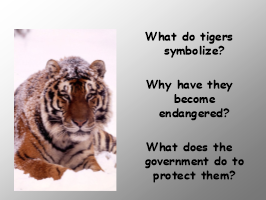
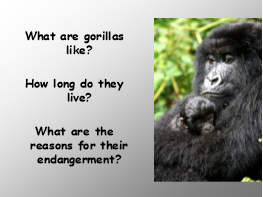
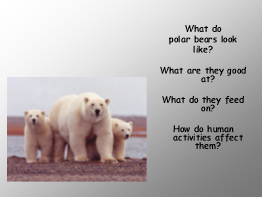
I hope you’ll be able to do it after reading some information.
Tigers
They are a symbol of power and strength. Many empires in India had them as their national symbol. The habitat loss has made these endangered animals homeless. Their population has reduced considerably in recent times. Another reason for their endangerment is their widespread poaching. They are killed for their bones, which are used in traditional Chinese medicines. They are also poached for their skins, which are used for making jackets and bags. The Government of India has established 37 reserves and wildlife sanctuaries for the conservation of this endangered species.
Gorillas
They have a vast resemblance to humans. They are non-violent and friendly creatures which get angry only when their families are threatened, especially their kids. Their life-span is 35 years in the wild, and 50 years in captivity. Deforestation has contributed in the loss of their habitat. Poaching is another great threat. Moreover, they are hunted for amusements in the circus.
Polar Bears
They have heavy white fur on their body, which insulates them from the extreme cold. They are swift runners, and usually cover hundreds of miles. Moreover, they are expert swimmers. Their diet generally consists of fish, seal, birds, seaweed, and grass. They have been affected by global warming. Habitat loss due to climate change is the major cause for their endangerment. Oil extraction from the Arctic Ocean is yet another cause for the endangerment of polar bears. It spreads the toxic chemicals in the seawaters, and pollutes the surroundings.
Students form groups, each group chooses the card, reads, guesses the name of the animal (it is not mentioned on their cards with the texts) and answers the questions from the presentation.
2. Vocabulary Practice (computer exercises)
Aim: to review vocabulary
Procedure: students in pairs discuss the difference between two types of causes, then do a vocabulary exercise followed by the whole class discussion
Materials: the presentation slide, a computer for each pair of students
Time: 5 min
Interaction: pair work, T – whole class
Look at these causes of animals becoming endangered. How is the first group different from the second?
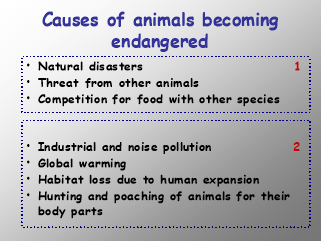
Now we’ll see how well you know the names of natural disasters. (computer vocabulary exercise)
Which one, in your opinion, causes the biggest threat for animals? Why?
3. Grammar Practice (computer presentation)
Aim: to revise and practice Conditionals I and II, to enlarge students’ vocabulary on the topic
Procedure: T elicits the answers from students while watching the presentation on the screen
Materials: the presentation on the huge screen for the whole class
Time: 10 min
Interaction: T – whole class



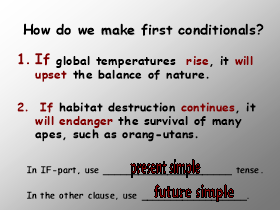
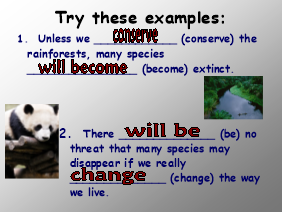
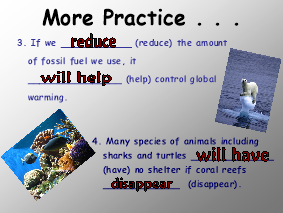
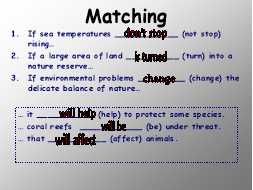


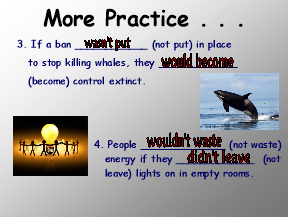
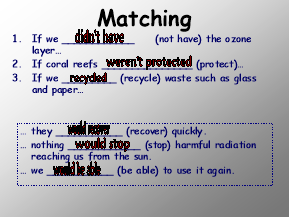
4. Matching reading and speaking
Aim: to develop reading and speaking skills (reading for gist)
Procedure: students form three groups and compete matching the headings to the paragraphs; checking – from the presentation slide
Materials: cards with headings for each team, cards with the text (gaps for headings)
Time: 5 min
Interaction: group work
What can we do to help the wildlife?
Conserve Habitats
When you visit a national park, make sure you obey the wildlife code: follow fire regulations; leave your pets at home; leave flowers or birds’ eggs where you find them; put your rubbish in a bin or, better still, take it home.
If you have friends who live on farms, encourage them to leave old trees standing, especially those with hollows suitable for nesting animals.
Make Space For Our Wildlife
Build a birdfeeder and establish a birdbath for the neighborhood birds.
Plant a tree and build a birdhouse in your backyard.
Recycle, Reduce, And Reuse
Encourage your family to take public transportation. Walk or ride bicycles rather than using the car.
Turn off the tap while you brush your teeth and use water-saving devices on your toilet and taps.
Join An Organization
There are many community groups working on conservation activities. Start helping today in your area!
Make Your Voice Heard
Write articles or letters about threatened species to newspapers.
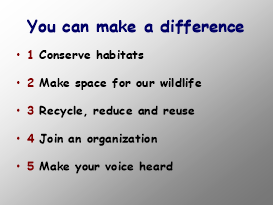
5.Watching a video
Aim: to develop reading and listening skills
Procedure: students do a pre-watching exercise, watch the video doing an exercise while watching and do after-watching exercise individually; then swap their texts with filled in gaps and see if they agree with their partner’s answer, if there is any disagreement discuss their answers
Materials: the video, cards with exercises
Time: 14 min
Interaction: individual work, pair work
Everyone can make a difference. Let’s watch the video and see what can be done.
Aquarium on Wheels
Before you watch
A Match the words to the meanings.
1 rainforest
2 aquarium
3 conservation
4 species
5 marine biology
a saving and protecting the environment
b a building where fish and underwater animals are kept and displayed
c the science of studying living things in the sea
d a thick forest of tall trees in a tropical area which receives a lot of rain
e a group of plants or animals which have the same main characteristics
While you watch
B Watch the DVD and circle the words you hear.
1 These students are employees / members of a very special programme called “Aquarium on Wheels”.
2 This year’s aim / goal is to explain the importance of the world’s rainforests to young people.
3 One set / group of skills that the secondary school students need are the communication skills necessary to get and keep a job.
4 I have been here for three years and I really feel like I’ve helped a lot of people learn about / understand conservation.
5 The programme really means a lot to me because I want to specialize / major in marine biology.
6 The Aquarium on Wheels programme is having a powerful impact / effect on more than just the rainforests.
After you watch
C Complete the summary of the DVD below using these words.
advantageous
better
coordinator
effect
future
lawyer
presentations
programme
satisfaction
skills
At the National Aquarium in Baltimore, some secondary school students take part in a(n) (1) __________ called “Aquarium on Wheels”. They prepare (2) __________ to educate and entertain school children who do not have the opportunity to go to the aquarium; so the aquarium is brought to them. These student employees also want to help children to (3) __________ understand conservation; for example, the fact that saving one tree can be important to all the animals in the rainforest.
Martha Schaum, the programme (4) __________, says the programme also offers the student employees lessons for life. They learn communication (5) __________, they learn about organization and planning and they also learn a bit about themselves. Some even find out what they want to be in the (6) __________. One student wants to be an environmental (7) __________ and another wants to be a marine biologist. The programme is (8) __________ both for the students and for Martha Schaum. It helps students prepare for their future professional lives and it allows Martha Schaum to achieve personal and professional (9) __________ from watching these teenagers grow. Aquarium on Wheels is having a positive (10) __________ on everybody involved with its very special programme.
Stage III. Summing up. Hometask
Aim: to get feedback from students
Procedure: students write their answers on separate pieces of paper and stick them to the board
Materials: sticky pieces of paper
Time: 3 min
Interaction: individual work
Write three points / issues / facts / pieces of information that impressed / surprised / interested you most of all during our today’s lesson concerning endangered species.
Now you can come and see if somebody else in the group shares your ideas.
You’ll be able to show once more what you’ve learnt after doing your hometask.
Write a text about any endangered species describing it, mentioning what problems it faces and suggesting possible solutions to them. Use conditionals in your writing.
Optional activities
Task 1 Vocabulary matching
Match these words to their definitions.
|
1. an animal that is hunted by another animal 2. a possibility that something bad will happen 3. the environment where an animal lives 4. destruction of land by water or sea 5. everything not made or controlled by humans 6. animals that hunt and kill 7. a group of plants or animals of the same kind 8. damage to air, land, water by chemicals and waste 9. animals and plants living in natural conditions 10. protection of natural things like forests 11. the land, water, air that people and animals live in 12. a person who fights for a particular social or political result
|
a) campaigner b) conservation c) environment d) erosion e) habitat f) nature g) pollution h) predators i) prey j) species k) threat l) wildlife
|
Task 2
Use of English – gap filling
POLAR BEARS
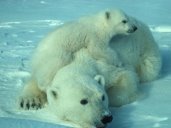
Polar bears are the 1) _____ carnivores in the world that live on land. They are found in the Arctic and their preferred 2) _____ is on top of the arctic ice. Here they hunt seals for food 3) _____ mate. Polar bears are very good swimmers; they paddle with their front 4) _____ and hold their hind legs flat to help them change direction. Sadly, polar bears are becoming seriously 5) _____ for a number of reasons. Oil companies are moving into 6) _____ areas, bringing a growing danger of oil pollution. At the same time, the arctic ice is melting due to global 7) _____. Polar bears feed on the ice so if it disappears, they will starve. A third danger comes 8) _____ over-hunting. Thankfully, 9) _____ organizations are now working to preserve parts of the Arctic and the 10) _____ that lives there. The Great Arctic Reserve, for example, is now a sanctuary for a variety of 11) _____, such as seals, wild reindeer and foxes.
|
1 |
A greatest |
B main |
C largest |
D chief |
|
2 |
A place |
B environs |
C house |
D habitat |
|
3 |
A that |
B and |
C with |
D but |
|
4 |
A tails |
B jaws |
C paws |
D feathers |
|
5 |
A scared |
B risked |
C alarmed |
D endangered |
|
6 |
A some |
B its |
C an |
D the |
|
7 |
A heating |
B warming |
C changing |
D airing |
|
8 |
A from |
B by |
C to |
D at |
|
9 |
A saving |
B preservation |
C conservation |
D protection |
|
10 |
A creatures |
B mammals |
C animals |
D wildlife |
|
11 |
A species |
B kinds |
C orders |
D families |
Task 3
Vocabulary matching
Match the words.
|
1. tidal 2. volcanic 3. global 4. forest 5. greenhouse 6. ozone 7. climate 8. balance 9. fossil 10. recycle 11. waste 12. become 13. habitat |
a) change b) destruction c) energy d) eruption e) extinct f) fire g) fuel h) gases i) layer j) of nature k) warming l) waste m) wave |


про публікацію авторської розробки
Додати розробку
